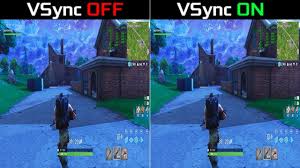You may not realize that the term ‘V-Sync’ stands for vertical synchronization, a crucial component in gaming that impacts your overall visual experience.
Have you ever wondered why screen tearing occurs or how to achieve smoother gameplay graphics?
Understanding V-Sync could be the key to enhancing your gaming performance. By grasping this concept, you might unlock a world of improved visuals and gameplay mechanics that you never knew were possible.
The Basics of V-Sync
When enabling V-Sync in gaming, your graphics card synchronizes the frame rate with your monitor’s refresh rate to reduce screen tearing. This synchronization ensures that the frames rendered by your graphics card align perfectly with the refresh rate of your monitor, preventing the phenomenon where parts of different frames are displayed simultaneously, causing a disjointed image known as screen tearing.
By capping the frame rate to match the monitor’s refresh rate, V-Sync helps create a smoother and more visually pleasing gaming experience. However, it’s important to note that enabling V-Sync can introduce input lag, as the graphics card may need to wait for the monitor to refresh before displaying a new frame. This delay can impact the responsiveness of your controls, which is a trade-off for eliminating screen tearing.
In essence, V-Sync acts as a mediator between your graphics card and monitor, ensuring that the images displayed are cohesive and free from tearing, albeit with a potential sacrifice in input responsiveness.
How V-Sync Works
To understand how V-Sync works in gaming, consider its role in coordinating frame rates and monitor refresh rates to ensure a seamless visual experience. When your GPU is rendering frames at a rate different from your monitor’s refresh rate, screen tearing can occur. V-Sync tackles this issue by synchronizing the GPU’s frame rate with the monitor’s refresh rate.
Here’s how it works: when V-Sync is enabled, the GPU sends a new frame to the monitor only when the monitor is ready to draw it. This coordination prevents tearing but can introduce input lag if the GPU is unable to keep up with the monitor’s refresh rate. When the GPU’s frame rate drops below the monitor’s refresh rate, V-Sync will cap the frame rate to prevent tearing, resulting in a smoother image but potentially lower performance. Understanding how V-Sync manages frame rates and refresh rates is crucial for optimizing your gaming experience.
Benefits of Using V-Sync
Using V-Sync in gaming can enhance visual quality by preventing screen tearing and ensuring smoother gameplay. Screen tearing occurs when the GPU sends a new frame to the monitor while it’s still displaying a previous frame, causing a visible split between the two. V-Sync resolves this issue by synchronizing the monitor’s refresh rate with the GPU’s frame rate, resulting in a more visually pleasing experience.
Additionally, V-Sync helps in reducing input lag, which is the delay between a player pressing a button and the action taking place on the screen. By keeping the frame rate in check and preventing abrupt frame switches, V-Sync contributes to a more responsive gaming experience. This is particularly important in fast-paced games where split-second decisions are crucial.
Moreover, using V-Sync can also help in extending the lifespan of your hardware. By regulating the frame rate and preventing excessive strain on the GPU, V-Sync can aid in maintaining the optimal performance of your gaming setup over time.
Drawbacks of V-Sync
While beneficial in many aspects, V-Sync in gaming does come with certain drawbacks that users should be aware of.
One major drawback of V-Sync is input lag. By synchronizing the frame rate with the monitor’s refresh rate, V-Sync can introduce a delay between when you input a command and when it’s displayed on the screen. This delay can be frustrating, especially in fast-paced games where split-second reactions are crucial.
Another issue with V-Sync is screen tearing. When the frame rate drops below the monitor’s refresh rate, V-Sync can cause the screen to display multiple incomplete frames at once, resulting in a torn or stuttering image. This can be distracting and negatively impact your gaming experience.
Furthermore, enabling V-Sync can sometimes lead to decreased performance, particularly on lower-end systems. Since V-Sync locks the frame rate to the monitor’s refresh rate, it can put additional strain on your hardware, causing lower frame rates and overall performance issues.
Tips for Optimizing V-Sync
Optimizing V-Sync can enhance your gaming experience by minimizing input lag and screen tearing issues. One tip to optimize V-Sync is to adjust your in-game graphics settings to ensure your system can consistently meet the monitor’s refresh rate. This will help prevent V-Sync from causing additional input lag.
Additionally, consider enabling triple buffering if your graphics card supports it. Triple buffering can help reduce input lag compared to double buffering while still preventing screen tearing.
Another optimization tip is to update your graphics card drivers regularly. New driver updates may include optimizations for V-Sync performance, ensuring smoother gameplay.
You should also consider using a G-Sync or FreeSync monitor if you have a compatible graphics card. These technologies dynamically adjust the monitor’s refresh rate to match the GPU’s output, eliminating the need for traditional V-Sync and reducing input lag.
Conclusion
Overall, understanding V-Sync is crucial for gamers looking to optimize their gaming experience. By knowing how V-Sync works, its benefits, drawbacks, and how to optimize it, players can ensure smoother gameplay and prevent screen tearing.
Whether you choose to use V-Sync or not, having this knowledge will empower you to make informed decisions when it comes to your gaming setup.
So, next time you’re tweaking your graphics settings, remember the importance of V-Sync.
